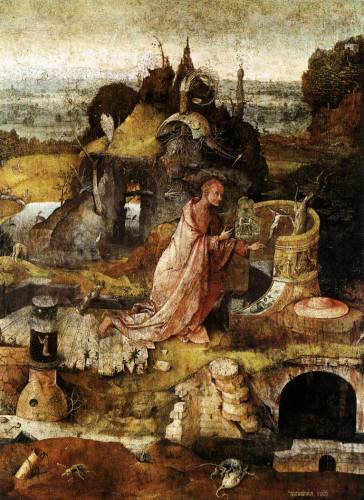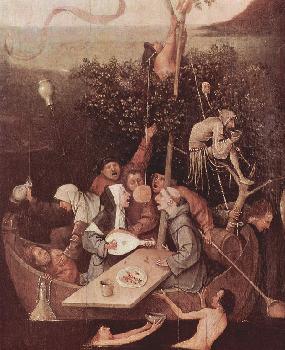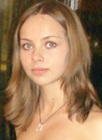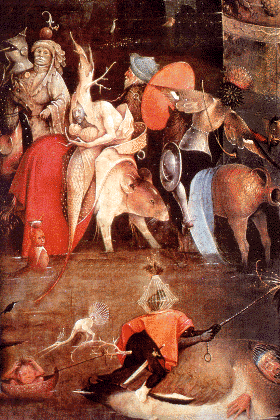|
Hieronymus Bosch
|
|
| Former-Teacher | Date: Thursday, 22.03.2012, 15:22 | Message # 1 |
 Dean
Group: Admins
Messages: 504
Status: Offline
| Discuss Bosch's art here.
|
| |
|
|
| Luck | Date: Thursday, 22.03.2012, 20:44 | Message # 2 |
|
Union organizer
Group: Friends
Messages: 172
Status: Offline
| The Last Judgement:
http://en.wikipedia.org/wiki/File:Last_judgement_Bosch.jpg
The left panel shows the Garden of Eden, at the top God is shown seated in Heaven while the Rebel Angels are cast out of Heaven are transformed into insects. At the bottom, God created Eve out of the rib of Adam, and as the panel goes higher while Eve is tempted by the Serpent (possibly Lilith) and are finally chased by the Angel into the dark forest signifying and dark sinful humanity, in the central panel where Jesus judges the souls while surrounded by the Saints, below is an earth ending by fire, where Demons seize the souls, and on the right panel is Hell where the wicked souls are punished.
|
| |
|
|
| MissJane | Date: Tuesday, 27.03.2012, 23:04 | Message # 3 |
 Union organizer
Group: Friends
Messages: 193
Status: Offline
| The Hermit Saint is a late triptych by Hieronymus Bosch, it dates back to 1505, but the year is often supposed to be incorrect.

The image here represents the central panel of the triptych. Here he enlarged the view of the landscape and sought to capture atmospheric effects. The painting is full of those bizarre and disquieting apparitions that are a distinctive feature of his works. The figure of St. Jerome bends towards the crucifixion thus symbolizing the only possible salvation for a religious soul. It saves from evil powers that are depicted through the ruins of a ritual place. the minor depictions are of great importance as well. The two disgusting animals (that look more like rats) struggling in front of the painting suggest another symbol - lies against the Church and filth. (The interpretation of this symbol was given by Stanley Meisler in his article "The World of Bosch.") The bones of some creature hint at the universal representation of death and Satan.
If you are much interested in Bosch's view of the world reflected in his painting, you are welcome to visit a webpage containing valuable information about the symbols in his major works.
|
| |
|
|
| MissJane | Date: Thursday, 12.04.2012, 15:05 | Message # 4 |
 Union organizer
Group: Friends
Messages: 193
Status: Offline
| Bosch is considered to be to a large extent a painter who focused on allegorical interpretation of the outside world, depicting humoristic scenes; at the same time these episodes contained the feeling of painful worry about the absurd condition of the humankind which is sinking in the ocean of evil and sin. Showing the plain routine of everyday life Bosch combined complex dark symbolism and picturesque details. The major masterpieces of Bosch are his enormous alter triptychs, e.g. The Garden of Earthly Delights and Temptation of St. Anthony.
Nevertheless, apart from triptychs, Bosch was vividly expressing his philosophy in smaller separate paintings. The Ship of Fools is a great mockery on the Biblical story of Noah. “This is how we live”, says Bosch, “we eat, drink, flirt, cheat, play silly games, pursue unattainable objectives. Meanwhile our ship drifts aimlessly and we never reach the harbour.” The ship is infinitely small representing our life flowing through the hugeness of the possibilities. The passengers of the boat are all fools; though there is a monk and a nun among them, we can’t say they are truly reli-gious people with strong belief in predestination. Why do they look so much like us? Why is this likeness so disturb-ing? This is because we choose wrong mirrors. If we observed our reflections in Bosch’s pictures more regularly, we would be aware of the vices that poison our existence. 
|
| |
|
|
| Ayayulia | Date: Thursday, 12.04.2012, 15:16 | Message # 5 |
 Union organizer
Group: Friends
Messages: 126
Status: Offline
| 
This image is an episode from the picture “the temptation of St.Anthony”. The picture illustrates the supernatural temptations faced by Saint Anthony the Great during his sojourn in the Egyptian desert. It has a form of triptych, and this frag-ment is the right part of a central part. The main colours are dark and deep. The background is dusky and frightening, all the characters are imaginable creatures, representing the inner world of a human being, that is in fact rather frail. We see a figure of a human being, represented by a tree, with a baby in his or her hand. It is coloured white and we can suppose that it can be Mary with the child. At first sight the picture seems as just a collection of some mysterious personages, but in fact it is much more difficult. Every detail has its own
message that we should be able to see.

|
| |
|
|
| Teacher | Date: Thursday, 12.04.2012, 15:38 | Message # 6 |
 Head teacher
Group: Admins
Messages: 375
Status: Offline
| Bosch and Brueghel are typical representatives of the Northern Renaissance. Their ideology has nothing in common with ideality and individuality of a human being. They view people as a part of the society the live in. The starting point of their oeuvre is actuality. The artists of the Northern Renaissance don’t deal with idealization in the process of human nature’s observation. For example, Bosch treats a man as an animal without dignity. The artists shows evil as a natural part of people’s self. More than that, Bosch believes that human beings can’t avoid being evil. And his shows this idea in a very pessimistic and exaggerated, fantastic way. His pictures are dreamlike. Bosch’s works are full of mysterious images and symbols that dazzle and captivate an observer into the world of the Northern Renais-sance.
In Vino Veritas...
|
| |
|
|
| Megastarosta | Date: Thursday, 12.04.2012, 21:57 | Message # 7 |
 Union organizer
Group: Friends
Messages: 126
Status: Offline
| Bosch and Bruegel are the central points in art that is opposed to the spirit of the Italian Renaissance. Bosch rejected the human point of view of man as a reasonable creature, capable of noble aspirations, infinitely perfectable. “The Temptation of St. Anthony”- here Bosch shows the saint seated among the fallen stones of a ruined building. In the background the smoke from a burning city darkens the sky.
Bosch, Hieronymus: The Temptation of St Anthony tryptych describing the ordeals of St Anthony. Boschs spiritual heroes were the saints who endured both physical and mental torment. Among the saints, Boschs favorite was Saint Anthony. we can see here features physical punishment on the left wing, a Black Mass in the center, and the blandishments of food and sex on the right wing.
|
| |
|
|
| Tanya | Date: Sunday, 22.04.2012, 14:59 | Message # 8 |
 Course monitor
Group: Friends
Messages: 61
Status: Offline
| Bosch was a Flemish Renaissance painter and printmaker known for his landscapes. Bosch studies the human condition as they see it reflected in the society of their time, and their observation of human nature rejects idealization to depend only upon an objective analysis of individual human characters. Bosch rejected the human point of view of man as a reasonable creature, capable of noble aspirations, infinitely perfectible. What Bosch saw instead was a depraved animal without dignity, for whom evil was the natural and inescapable condition. He expressed this pessimistic sense of human frailty in fantastic, dreamlike images of enormous power. One of his famous works is “The Temptation of St. Anthony”. The effect is fascinating and disturbing, as our eyes fall on the complex assembly of mysterious images. Bosch expressed this pessimistic sense of human frailty in fantastic, dreamlike images of enormous power. This work is full of different symbols. It speaks about mental and spiritual torments, temptations and horrors of sin and evil.
|
| |
|
|












